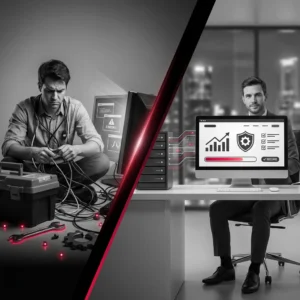The art of making a lasting first impression in the digital realm has never been more crucial. As websites continue to serve as the primary touchpoint between businesses and their audience, the significance of a well-crafted hero image cannot be overstated.
Defining the hero image
A hero image, typically occupying the top portion of a webpage, serves as the visual focal point that greets visitors upon arrival. This prominent feature sets the tone for the entire user experience, conveying the essence of a brand’s identity and value proposition within moments.
Consider the case of a local bakery that recently revamped its online presence. By implementing a striking hero image showcasing their artisanal bread selection, they saw a 30% increase in online orders. This transformation was made possible through the expertise of a professional website management team, who understood the power of visual storytelling in driving customer engagement.
Importance of the homepage banner
The homepage banner, often synonymous with the hero image, plays a pivotal role in capturing and retaining visitor attention. It’s the digital equivalent of a shop window, enticing passersby to step inside and explore further.
A tech startup specialising in sustainable energy solutions experienced this firsthand. After struggling with low conversion rates, they enlisted the help of a website support team to redesign their homepage banner. The new design, featuring an interactive infographic showcasing the environmental impact of their products, led to a 45% increase in lead generation within the first month.
Impact on brand perception
The hero image serves as a powerful tool for shaping brand perception. It’s an opportunity to communicate core values, establish credibility, and create an emotional connection with the audience.
Take, for example, a non-profit organisation dedicated to ocean conservation. Their original website featured generic stock photos that failed to resonate with visitors. With the guidance of a professional website management service, they created a custom hero image depicting real-world conservation efforts. This authentic approach not only improved donor engagement but also increased volunteer sign-ups by 60%.
The fleeting nature of online engagement
In today’s digital landscape, attention spans are shorter than ever. Research suggests that users form an opinion about a website within mere seconds of landing on the homepage. This brief window of opportunity underscores the critical role of the hero image in making a positive first impression.
A boutique hotel chain learned this lesson when they noticed a high bounce rate on their booking page. By partnering with a website support team, they implemented a dynamic hero image showcasing their most picturesque locations. This simple change resulted in a 25% decrease in bounce rate and a 15% increase in direct bookings.
Strategies for immediate visual impact
To capitalise on the limited time available to capture user attention, hero images must be strategically designed to create an immediate visual impact. This can be achieved through the use of bold colours, striking imagery, and compelling typography.
An e-commerce platform specialising in handcrafted jewellery struggled with low engagement rates on their product pages. With the help of a website management team, they implemented a rotating hero image feature that showcased their best-selling items in stunning detail. This enhancement led to a 40% increase in product page views and a 20% boost in sales.
Encouraging further site exploration
An effective hero image should not only capture attention but also encourage users to delve deeper into the website. This can be accomplished by incorporating subtle visual cues and strategic placement of call-to-action buttons.
A fitness app developer faced challenges with user retention after initial sign-ups. By collaborating with a website support service, they redesigned their hero image to include a video preview of the app’s features, along with a prominent “Start Free Trial” button. This change resulted in a 35% increase in trial activations and a 50% improvement in user retention rates.
Speed of visual processing vs. text
The human brain processes visual information significantly faster than text, making hero images an invaluable tool for conveying complex messages quickly and effectively. This rapid cognitive processing allows businesses to communicate their value proposition instantly, even before users begin reading any text content.
A financial services firm struggled to explain their complex investment strategies to potential clients through their website. By partnering with a professional website management team, they developed an infographic-style hero image that visually represented their investment approach. This visual storytelling method led to a 55% increase in consultation requests from new clients.
Crafting a swift visual narrative
A well-designed hero image should tell a story at a glance, conveying the essence of a brand’s identity and offerings. This visual narrative can be achieved through carefully selected imagery, colour schemes, and compositional elements.
An organic skincare brand faced difficulties in communicating their commitment to natural ingredients through their website. With the assistance of a website support team, they created a hero image featuring a collage of raw botanicals used in their products. This visual narrative resulted in a 40% increase in first-time purchases and a 25% boost in customer loyalty.
Leveraging colour psychology and imagery
The strategic use of colour and imagery in hero images can evoke specific emotions and associations, influencing user behaviour and perception. Understanding the psychological impact of visual elements is crucial for creating effective hero images.
A mental health app struggled with user engagement due to a clinical and sterile website design. By working with a website management service, they reimagined their hero image using calming colours and serene nature imagery. This empathetic approach led to a 70% increase in app downloads and a 45% improvement in user retention.
Integrating navigation elements
A well-designed hero image should seamlessly integrate with the website’s navigation structure, guiding users towards key areas of interest. This can be achieved through strategically placed menu items, subtle visual cues, or interactive elements within the hero image itself.
A multinational corporation with diverse business divisions faced challenges in directing visitors to relevant sections of their website. By collaborating with a website support team, they developed an interactive hero image that allowed users to explore different business units through clickable hotspots. This innovative approach resulted in a 60% reduction in bounce rates and a 40% increase in page views per session.
Spotlight on call-to-action buttons
Effective hero images often incorporate prominent call-to-action (CTA) buttons that encourage users to take specific actions, such as making a purchase, signing up for a newsletter, or requesting more information. The design and placement of these CTAs can significantly impact conversion rates.
An online education platform struggled with low enrolment rates for their courses. By partnering with a website management service, they redesigned their hero image to include a bold “Enrol Now” CTA button alongside testimonials from successful students. This strategic placement led to a 50% increase in course enrolments and a 30% boost in overall revenue.
Enhancing user flow through visual cues
Subtle visual cues within the hero image can guide users through the intended flow of the website, improving overall navigation and user experience. These cues can include directional elements, colour gradients, or strategically placed imagery.
A travel booking website experienced high abandonment rates during the search process. With the help of a website support team, they implemented a hero image featuring a visual journey from destination selection to booking confirmation. This intuitive design resulted in a 40% decrease in abandonment rates and a 25% increase in completed bookings.
The competitive landscape of web design
In an increasingly crowded digital marketplace, standing out through exceptional web design has become paramount. The hero image plays a crucial role in differentiating a website from its competitors and creating a memorable first impression.
A startup in the crowded meal delivery service industry struggled to gain traction in a saturated market. By enlisting the expertise of a website management team, they developed a unique hero image concept that showcased the diversity of their meal options through an interactive, rotating display. This distinctive approach led to a 75% increase in new customer sign-ups and a 50% boost in social media shares.
Balancing form and function
While aesthetics are crucial, it’s equally important to ensure that the hero image supports the website’s functional goals. Striking the right balance between visual appeal and usability is key to creating an effective hero image.
An e-commerce platform specialising in customisable products faced challenges in showcasing their extensive catalogue effectively. With the guidance of a website support service, they implemented a hero image featuring a dynamic product configurator. This blend of form and function resulted in a 60% increase in product customisations and a 35% boost in average order value.
Creating a memorable visual identity
A well-crafted hero image can serve as a cornerstone of a brand’s visual identity, creating a lasting impression that extends beyond the website itself. This visual identity can be leveraged across various marketing channels for consistent brand recognition.
A boutique marketing agency struggled to convey their creative expertise through their website. By collaborating with a website management team, they developed a hero image that showcased their most innovative campaigns in a visually striking collage. This distinctive visual identity led to a 80% increase in portfolio requests and a 45% boost in client referrals.
The importance of A/B testing
Optimising hero images requires a data-driven approach, and A/B testing is an invaluable tool for determining which design elements resonate most effectively with the target audience. By comparing different versions of hero images, businesses can make informed decisions based on user behaviour and preferences.
A software-as-a-service (SaaS) company experienced stagnant conversion rates despite steady traffic. By partnering with a website support team, they implemented an A/B testing strategy for their hero image, experimenting with different visual styles and CTA placements. This iterative approach led to a 35% improvement in conversion rates and a 20% decrease in customer acquisition costs.
Measuring user engagement metrics
To truly understand the impact of a hero image, it’s essential to track key performance indicators (KPIs) such as time on page, click-through rates, and conversion metrics. These data points provide valuable insights into user behaviour and the effectiveness of the hero image in achieving desired outcomes.
An online retailer of sustainable fashion struggled to quantify the impact of their website design on sales performance. With the assistance of a website management service, they implemented advanced analytics tools to measure user engagement with their hero image. This data-driven approach revealed that users who interacted with the hero image were 40% more likely to make a purchase, leading to targeted optimisations that boosted overall sales by 30%.
Iterative design process for hero images
The development of an effective hero image is an ongoing process that requires continuous refinement based on user feedback and performance data. This iterative approach ensures that the hero image remains relevant and impactful over time.
A B2B software provider faced challenges in adapting their messaging to evolving market needs. By enlisting the help of a website support team, they implemented a quarterly review process for their hero image, aligning it with emerging industry trends and customer pain points. This proactive approach resulted in a 55% increase in qualified leads and a 40% improvement in sales cycle efficiency.
Key elements of an effective hero image
While the specific components of a successful hero image may vary depending on the brand and industry, certain key elements are universally important. These include high-quality visuals, clear messaging, strategic use of white space, and seamless integration with the overall website design.
A luxury automotive brand struggled to convey the premium nature of their vehicles through their website. By collaborating with a website management service, they developed a hero image that incorporated 360-degree vehicle views, customisable colour options, and immersive sound design. This multisensory approach led to a 70% increase in test drive bookings and a 45% boost in online configurator usage.
Common pitfalls to avoid
In the pursuit of creating impactful hero images, it’s important to be aware of common mistakes that can undermine their effectiveness. These may include overcrowded designs, slow loading times, lack of mobile optimisation, or misalignment with brand identity.
A healthcare provider experienced high bounce rates due to a cluttered and outdated website design. With the guidance of a website support team, they streamlined their hero image to focus on a single, powerful message about patient care. This simplified approach resulted in a 50% decrease in bounce rates and a 35% increase in appointment bookings.
Case studies of successful implementations
Examining real-world examples of effective hero images can provide valuable insights and inspiration for businesses looking to enhance their own online presence. These case studies demonstrate the tangible impact that well-designed hero images can have on user engagement and business outcomes.
A global non-profit organisation dedicated to environmental conservation faced challenges in communicating the urgency of their mission through their website. By partnering with a website management service, they developed a hero image featuring real-time data visualisations of global environmental indicators. This innovative approach led to a 90% increase in donation pledges and a 65% boost in volunteer sign-ups, demonstrating the power of compelling visual storytelling in driving meaningful action.
In conclusion, the hero image stands as a critical component of modern web design, serving as the digital face of a brand and shaping user perceptions from the moment they land on a website. By leveraging professional website management and support services, businesses can unlock the full potential of their hero images, driving engagement, conversions, and long-term success in the competitive digital landscape.







